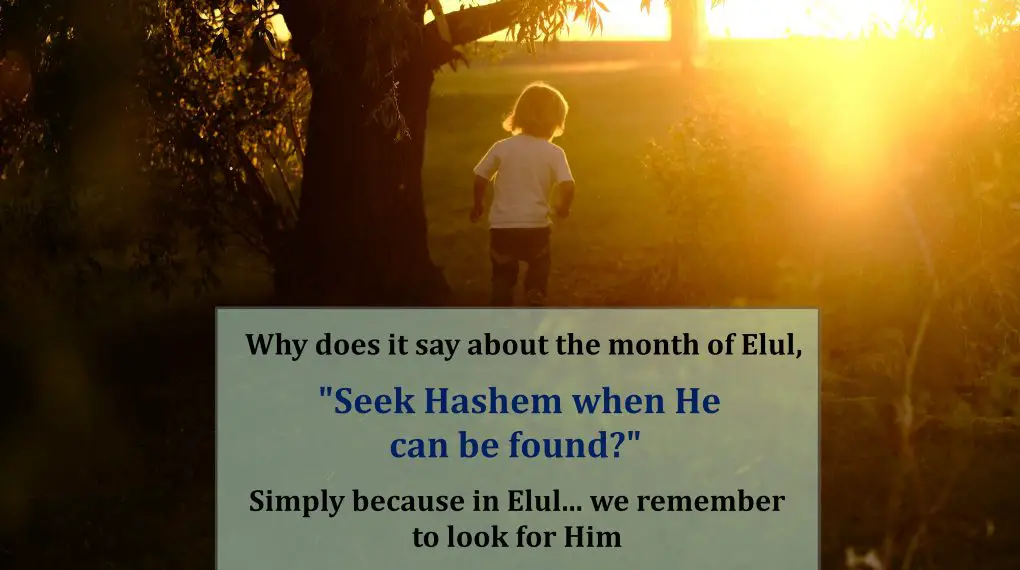BS”D
Seek Hashem when He can be found. Call upon Him when He is near.
Yeshayah 55:6
According to Chazal, this possuk refers to Elul and even more so to the Ten Days of Repentance.
Even though repentance and petition are always appropriate, during the ten days between Rosh HaShanah and Yom HaKipurim it is even more appropriate and it is accepted immediately…
Rambam, Hilchos Teshuva 2:6-7
But, why specifically is HaShem found more during these days? How is He more “there”? And, what does it mean that we should “seek Him”?
Elul and the Ten Days of Repentance: A Time to Mend
 According to Kabbalistic sources, every period in the Jewish calendar has its own inherent spiritual potential and unique influence on the world. There is a specific flow of spiritual energy every month, week, day, and even hour that we can tap into if we choose. Shabbos, for example, is the source of brocha for all six days of the week. If we can connect to the brocha and the abundance inherent to Shabbos we not only can improve our physical circumstances, but tap into an intense Divine light, clarity and spiritual awareness. This spiritual blessing will give us the strength and insight to do teshuva and overcome the challenges of the coming week.
According to Kabbalistic sources, every period in the Jewish calendar has its own inherent spiritual potential and unique influence on the world. There is a specific flow of spiritual energy every month, week, day, and even hour that we can tap into if we choose. Shabbos, for example, is the source of brocha for all six days of the week. If we can connect to the brocha and the abundance inherent to Shabbos we not only can improve our physical circumstances, but tap into an intense Divine light, clarity and spiritual awareness. This spiritual blessing will give us the strength and insight to do teshuva and overcome the challenges of the coming week.
A similar phenomenon can be seen in the weeks leading up to Pesach. There is an almost palpable energy in the air that influences people to get rid of all of the clutter in their lives, to clean up and organize, to let go and get rid of the things that are distracting and taking up more space than they should. Even in the world at large there is the concept of “spring cleaning.” When we let go of the things that are keeping us from HaShem and our spiritual potential that’s when miracles happen.
Every moment has such a high level of potential.
By developing our awareness of spiritual dimension embedded in each time period, we can bring down physical and spiritual brocha and abundance into our lives that will help us to gain clarity, refine our character traits and ultimately come closer to HaShem and our true selves.
During Elul and the Ten Days of Repentance, HaShem is mashpia into the world forces of rebirth and rejuvenation. These forces ultimately arouse in us the desire to return to Him, to do teshuva. It’s in the air, and anyone with even a bit of sensitivity will be swept along with it in some way.
That’s why Elul and the Ten Days of Repentance are such a natural time for reflection and cheshbon hanefesh, a time when Jews learn more Torah than usual and busy themselves with abundant tefillas and mitzvahs. And, this is even for the Jews who aren’t so passionate about these activities during the rest of the year.
But, that’s not all…
The desire to return to Hashem is fundamentally based on an awareness of His presence and the recognition of His closeness. The more the person feels HaShem, the more he is inspired to return to Him.
The chesod of the month of Elul and the Ten Days of Repentance is that HaShem peels back a bit of the blockage on our hearts with every blow of the shofar, every time we get up in the middle of the night to say slichos, every tefilla we utter and every single thought of teshuva no matter how fleeting it is.
The spiritual influence of these days combined with the constant “reminders” of HaShem’s Presence, inspires us to seek HaShem all the more, and when we sincerely seek out HaShem, we often find that He was not far at all. In fact, we come to realize that HaShem was, and is, right there with us. Through all the ups and downs, HaShem never abandons us. All the distance and hiddeness is really just an illusion.
As the Kotsker Rebbe once said, “the seeking is the finding.”
So HaShem is more found during these days not because He has somehow changed. He seems closer and more accessible simply because during this time we are more inspired to look for Him.



